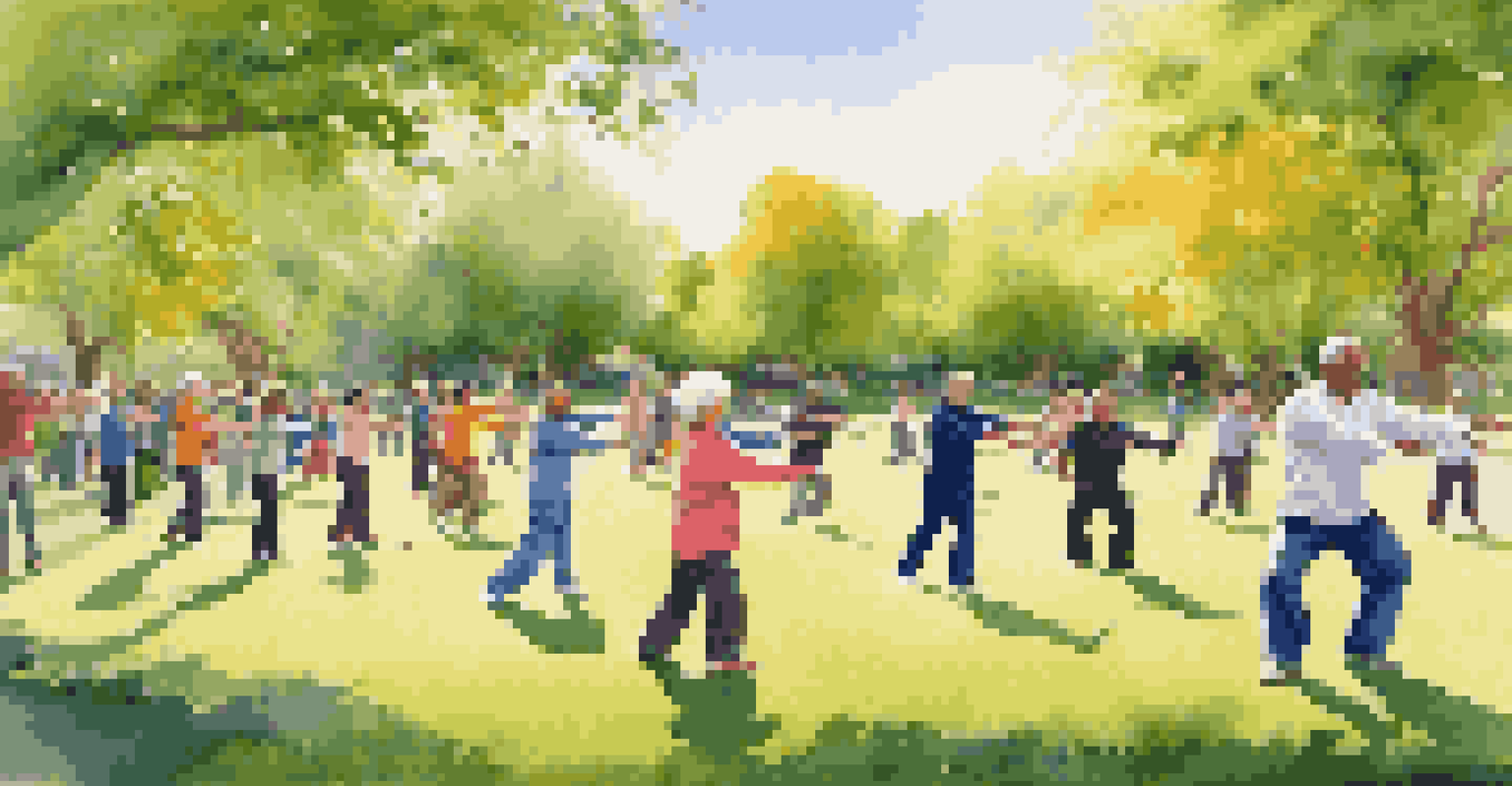Utilizing Tai Chi for Pain Management: Techniques and Benefits

Understanding Tai Chi: A Gentle Approach to Movement
Tai Chi, often described as 'meditation in motion,' involves slow, flowing movements that promote relaxation and balance. Originating from ancient Chinese martial arts, it focuses on cultivating both physical and mental well-being. This gentle practice is accessible to people of all ages and fitness levels, making it a popular choice for those seeking pain relief.
Tai Chi is not about the destination, but about the journey of movement and mindfulness.
The essence of Tai Chi lies in its emphasis on mindfulness and breath control. As practitioners move gracefully through each form, they become more aware of their bodies and sensations. This heightened awareness can lead to better posture, improved flexibility, and ultimately, reduced pain.
For many, Tai Chi serves as a form of active meditation, allowing individuals to connect with their inner selves while alleviating stress and tension. By integrating body and mind, Tai Chi creates a holistic approach to pain management that addresses both physical discomfort and emotional well-being.
The Science Behind Tai Chi and Pain Relief
Research has shown that Tai Chi can be an effective intervention for various types of pain, including chronic conditions such as arthritis and lower back pain. Studies indicate that the gentle movements can improve circulation, reduce inflammation, and enhance overall mobility. These physiological benefits contribute to a decrease in pain perception.

Moreover, Tai Chi encourages the release of endorphins, the body's natural painkillers. These feel-good hormones play a significant role in mood enhancement and pain reduction. As practitioners engage in regular practice, they may find that their pain levels diminish, providing a sense of empowerment over their condition.
Tai Chi Promotes Relaxation and Balance
The gentle movements of Tai Chi foster mindfulness and help individuals connect with their bodies, leading to improved posture and reduced pain.
Importantly, Tai Chi also incorporates mindfulness techniques, which can help individuals manage the psychological aspects of pain. By focusing on breath and movement, practitioners can cultivate a sense of calm and resilience, equipping them with tools to cope with discomfort more effectively.
Key Tai Chi Techniques for Pain Management
Several specific Tai Chi techniques can be particularly beneficial for pain management. One popular practice is the 'Cloud Hands' movement, which promotes gentle rotation of the torso and arms, enhancing flexibility and reducing tension in the back and shoulders. This technique is often recommended for those experiencing stiffness or discomfort in these areas.
Pain is inevitable, but suffering is optional. Tai Chi teaches us to embrace the moment and find peace within.
Another valuable technique is the 'Single Whip,' which encourages balance and coordination. This movement can strengthen the legs and improve stability, making it an excellent choice for individuals with joint pain or mobility issues. Practicing these movements mindfully helps reinforce body awareness, which can further aid in pain relief.
Incorporating deep breathing into these movements is essential. As you practice Tai Chi, focus on slow, deep breaths that synchronize with your movements. This combination of breath and motion can amplify the relaxation response, helping to alleviate pain more effectively.
Adapting Tai Chi for Individual Needs
One of the most appealing aspects of Tai Chi is its adaptability. Whether you're dealing with chronic pain, recovering from an injury, or simply looking to enhance your overall health, Tai Chi can be modified to suit your specific needs. Many instructors offer classes tailored to different skill levels and physical limitations.
For those with severe pain or mobility challenges, seated Tai Chi is an excellent alternative. Practicing from a chair allows individuals to benefit from the gentle movements and breathing techniques without putting undue stress on their bodies. This inclusive approach makes Tai Chi accessible to a broader audience.
Effective Pain Management Techniques
Specific Tai Chi techniques, such as 'Cloud Hands' and 'Single Whip,' enhance flexibility and stability, making them beneficial for pain relief.
It's also important to listen to your body during practice. If a certain movement causes discomfort, it's perfectly acceptable to modify it or skip it altogether. By paying attention to your body's signals, you can create a safe and effective pain management strategy through Tai Chi.
Building a Consistent Tai Chi Practice
Consistency is key when it comes to reaping the benefits of Tai Chi for pain management. Aim to practice regularly, even if it's just for a few minutes each day. Establishing a routine can help reinforce the positive effects on both your body and mind.
Consider joining a local Tai Chi class or finding online resources to guide your practice. Participating in a community can provide motivation and support, making the journey toward pain management more enjoyable and fulfilling. Plus, learning from experienced instructors can ensure you're performing the movements correctly and safely.
As you build your practice, keep track of your progress. Noticing improvements in your flexibility, balance, or overall well-being can be incredibly motivating and affirm your commitment to this holistic approach to pain management.
Complementing Tai Chi with Other Pain Management Strategies
While Tai Chi can be a powerful tool for pain management, it's often most effective when combined with other therapeutic approaches. Consider integrating practices such as physical therapy, massage, or acupuncture into your routine. This multi-faceted approach can enhance your overall results and provide a more comprehensive pain management strategy.
Nutrition also plays a crucial role in pain management. A balanced diet rich in anti-inflammatory foods can help reduce pain and improve recovery. Pairing Tai Chi with healthy eating habits creates a synergistic effect that promotes both physical and emotional health.
Consistency Enhances Tai Chi Benefits
Regular practice of Tai Chi, whether in a class or at home, reinforces its positive effects on pain management and overall well-being.
Lastly, don't underestimate the power of community support. Engaging with others who share similar experiences can provide encouragement and motivation. Whether through group classes or online forums, connecting with fellow Tai Chi practitioners can enhance your journey toward pain relief.
Real-Life Success Stories of Tai Chi for Pain Relief
Numerous individuals have found success in managing their pain through Tai Chi, and their stories can be truly inspiring. For instance, one woman suffering from chronic back pain discovered that regular Tai Chi practice not only alleviated her discomfort but also improved her overall quality of life. She reported feeling more energetic and connected to her body.
Another man with arthritis in his knees shared how Tai Chi transformed his daily routine. Initially skeptical, he was amazed at how gentle movements helped him regain mobility and reduce stiffness. Now, he enjoys activities he once thought were impossible, all thanks to his newfound strength and flexibility.

These success stories highlight the potential of Tai Chi as a viable pain management strategy. While each person's journey is unique, the common thread is the empowerment that comes from taking control of one's health through mindful movement and practice.